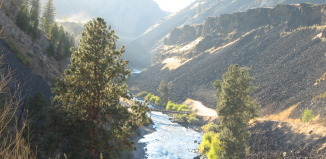Idaho scorpions and scorpion wannabes
From Dr. Edward J. Bechinski — University of Idaho Extensions
MOSCOW, Idaho — Arachnid is the scientific classification for all eight-legged insects. Spiders are the biggest group of arachnids, with nearly 3,800 known in the U.S. and Canada. But the arachnid category includes other types of eight-legged creatures that sometimes cause concern. Some of Idaho’s non-spider arachnids, such as scorpions, pose potential threats to human health. Two related non-spider arachnids – sun scorpions and pseudoscorpions – look fearsome but are entirely harmless.
This article will help you identify these three groups and understand the threats they pose. All three of these groups are almost always seen as lone individuals that do not require any control.
Scorpions
IDENTIFICATION AND BIOLOGY
Scorpions are easily identified by their claw-like pincers at the front of their head and their thin, many segmented abdomen that ends in a large bulb with a curved stinger at the tip (figure 1). Five species ranging in size from two to seven inches long occur in Idaho. Scorpions primarily occur in sagebrush deserts in the southern half of Idaho, but one species – the northern scorpion – occurs as far north as Lewiston along the Snake River canyon of north-central Idaho. This species lives in the northernmost location of any scorpion in the U.S.
Scorpions give birth to several dozen live young that crawl onto their mother’s back (figure 2) where they remain for several weeks without feeding and then disperse. Development to adult can take more than a year and adults can live for several years.
Scorpions are nocturnal predators of insects and other arthropods. They hide by day under rocks, stacked wood and other protected sites and hunt at night for insects and other prey. Scorpions kill small prey by physically crushing them with their claws while large prey are subdued by stinging. Scorpions sting by flexing their abdomen forward over their body and stabbing prey with the curved, hollow stinger.
Pest status
None of our Idaho Scorpions pose a significant threat to human health. The only exception is for those rare people with allergies to scorpion venom, to whom stings can be life-threatening. In an allergic reaction, it is not the poison in the venom that are harmful, but rather the body’s over response to otherwise harmless proteins in the venom.
The dangerous reputation of scorpions is grossly exaggerated. All scorpions produce venom delivered via the sting. Our scorpions do sting defensively when disturbed such as turning over a rock where a scorpion is hiding. The pain is similar to a bee sting. Localized swelling and a black and blue discoloration can last several days.
Only one species in the U.S. – the Arizona bark scorpion — is a significant medial threat. This species, not known in Idaho, occurs in Arizona and nearby regions of southern California, Utah and New Mexico. Sting deaths from this scorpion are extremely rare: no human fatalities have been documented for more than four decades. The primary danger from this species is to small children weighing less than 30 pounds.
Psuedoscorpions
IDENTIFICATION AND BIOLOGY
Psuedoscorpions literally false scorpions, are small (1/8 to ¼ inches long), harmless arachnids that resemble true scorpions (Figure 3). Like true scorpions, these pretenders have big pincers at the front of the head. However, they do not have the long, thin abdomen of a scorpion, and they entirely lack a stinger. Pseudoscorpions mainly live outdoors under leaf litter, moss or loose bark where they are predators of tiny soil-dwelling arthropods.
Pest Status
Though frightening in appearance, Pseudoscorpions neither bite nor sting and so are completely harmless to people. They do produce venom from their claws that are used to kill prey. Lone specimens in homes are likely carried in with firewood. No control action is needed.
Sun Scorpions
IDENTIFICATION AND BIOLOGY
Sun scorpions are scary looking but essentially harmless arachnids (Figure 4) that are also known as sun spiders, wind scorpions and wind spiders. They also occur statewide but most are common in sagebrush plains and canyon lands of southern Idaho.
In spite of their name they are neither scorpions nor spiders. Sun refers to their preferred habitat of sunny desert lands where true scorpions and spiders also live. The other names come from their behavior of running so rapidly they appear to be tumbling over the ground with the wind.
Sun scorpions are easily identified by their, massive jaws that project forward as toothed pincers-jaws. At first glance, sun scorpions look like they have five pairs of legs, but actually have only four pairs. The five-legged appearance come from their long slender pedipalps, which they raise forward off the ground, together with their first pair of real legs, and use as feelers. Their yellow-brown body is covered with hairs.
Most Idaho sun scorpions are night-active predators that seek shelter from the sun under rocks during the day. They use their stout pincer-jaws to capture and consume prey, other arachnids and sometimes small lizards.
Pest Status
Individual specimens sometimes wander into homes (especially residences that adjoin sagebrush rangelands), where they cause concern but pose no significant threat. They will bite defensively if mishandled or threatened. Although bites can be painful, sun scorpions are not venomous. They do not have poison glands, nor do they have fangs, If they break the skin, the main threat is a secondary infection of the wound.




